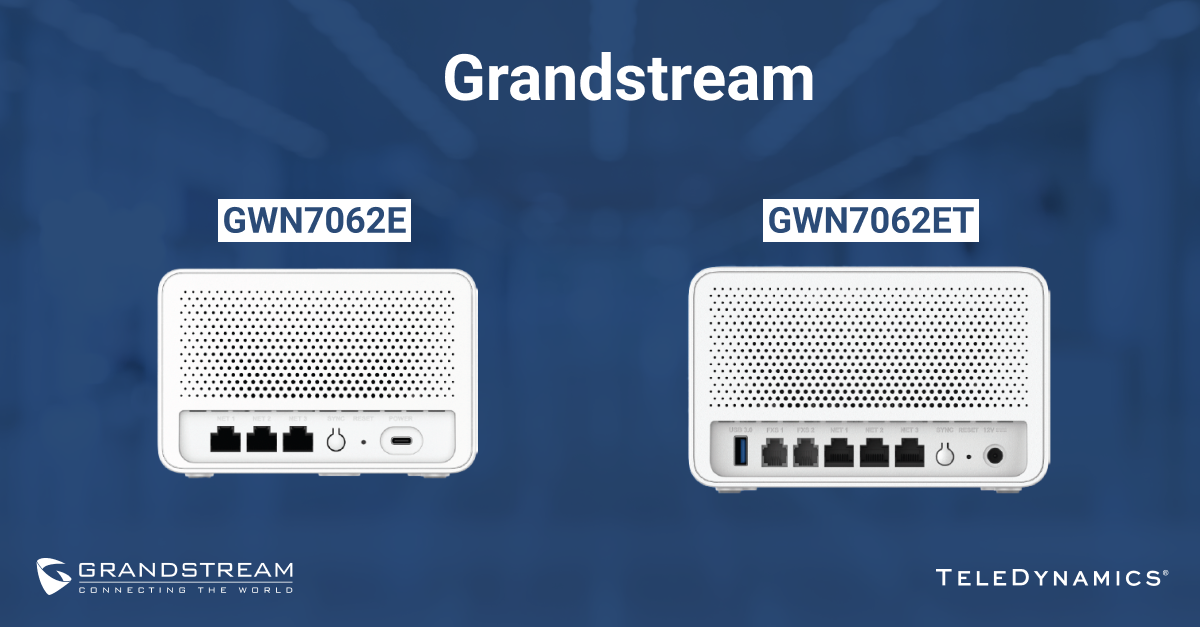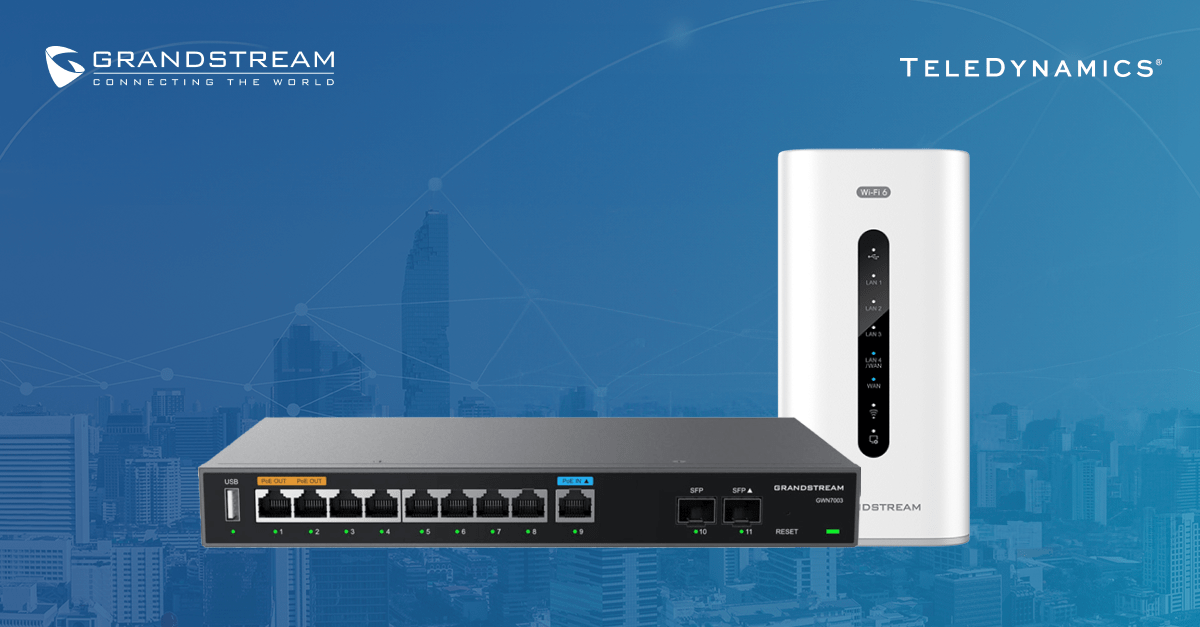Are your customers demanding faster, more reliable Wi-Fi in their small offices or to support their distributed workers spread across different satellite branches? You’re not alone. Hybrid work continues to be a significant part of SMB workplace culture, making the ability to provide enterprise-grade wireless performance on a tight budget fundamentally important.
Having the right Wi-Fi 6 router can make or break a deployment. In this review, we take a close look at the GWN7062E and the GWN7062ET, two of Grandstream’s affordable dual-band Wi-Fi 6 routers that aim to strike a balance among performance, security, and ease of deployment.
Read More
Topics:
Grandstream,
Mobility (including remote work),
Routers,
Wi-Fi
As more businesses shift to cloud-based communications and remote workforces become the norm, ensuring consistent performance across dispersed sites has become a top priority for telecom and UC providers. For installers and resellers tasked with deploying reliable real-time communications services like VoIP and UC, the choice of underlying network transport can make or break performance.
Multiprotocol Label Switching (MPLS) is not new, but it continues to play a critical role in meeting the low latency, high reliability, and QoS demands of these modern deployments. In this article, we examine the performance of MPLS in supporting real-time communications and why it remains a go-to solution for interconnecting geographically distributed infrastructure.
Read More
Topics:
QoS,
Routers,
Network Design,
Cloud,
Unified Communications,
WAN Technology,
Network Infrastructure
Routing is a vital part of network operations, and employing it correctly is of utmost importance for any enterprise network.
In the context of networking, routing is the process by which data packets are directed to their final destination as they travel from node to node. There are many aspects of routing design that can affect general network traffic patterns and particular network services. UC and VoIP services can be adversely affected if routing design does not take into account their special characteristics.
This article examines various aspects of routing implementation to see how it can potentially affect real-time services. We also look at what specific design aspects you should consider to ensure the proper operation of such services.
Read More
Topics:
VoIP,
Troubleshooting,
Routers,
Network Design,
Unified Communications,
Network Infrastructure,
Protocols & codecs
Network switches are essential to enterprise networks, offering various capabilities and functions. Some switches are configurable, and others are not. Some operate at layer 2 of the OSI model, while others function at layer 3.
With so many variations, comprehending switch capabilities can sometimes be overwhelming. This article simplifies these concepts to help you better understand how each type of switch can benefit your network.
Read More
Topics:
Routers,
Network Design,
Switches,
Unified Communications
By Brian Van Meter at Grandstream
Two of the key use cases for a VPN are to connect multiple sites together, such as an enterprise's satellite offices to its central headquarters, and to provide remote workers to a central network so they may access an organization's network resources.
VPNs are widely used throughout business, education, local government, and other deployment verticals that require dispersed locations to be connected together. Within this blog post, we'll be discussing the types of VPNs that you can create with Grandstream's GWN series of routers, and how you can use them to connect workers into one centralized network.
Read More
Topics:
Grandstream,
Network Security,
Routers
Grandstream has again raised the bar by unveiling a new series of groundbreaking Wi-Fi routers. The new GWN7052 and GWN7052F routers deliver faster speeds, higher capacities and innovative features ideal for residential users, small businesses and more extensive campus networks.
This article takes a closer look at the capabilities of these new devices and the benefits you can expect from their deployment.
Read More
Topics:
Wireless,
Grandstream,
Routers,
Wi-Fi
A major challenge inherent in designing and maintaining an enterprise network is the administration costs. Software-defined networking (SDN) can dramatically reduce both the hard costs (money) and soft costs (time) of managing a network. Although this tends to be the most compelling argument in favor of using SDN, it in fact offers may more advantages than this. In this article, we introduce SDN and examine some of its key benefits.
Read More
Topics:
Trends,
Productivity,
Routers,
Network Design,
Gateway,
Switches,
Unified Communications
IP Telephony features are not always “plug-and-play.” Rather, they must be configured to function properly. This is equally true when dealing with quality of service (QoS) on a network that transmits both data and voice (i.e., a converged network).
Companies commonly find that when they install their VoIP system on a preexisting data network, it works great at first. Days or weeks later, however, users complain of poor voice quality and intermittent disconnections. The network has not changed, so what’s going on?
In this article, we’ll see why QoS is a fundamental part of your network design for voice, and examine five configurations that should always be employed to achieve high-quality voice on a converged network.
Read More
Topics:
QoS,
VoIP,
Routers,
Network Design,
Switches
Product Review
Since launching its GWN7610 Wi-Fi access point in 2016, Grandstream has grown its GWN Series to include a range of access points plus a Gigabit VPN router to offer a complete wired and Wi-Fi solution. In addition to the GWN7610 enterprise access point (“AP”) we reviewed in 2016, Grandstream has since launched the GWN7600 mid-range AP, the GWN7600LR outdoor long-range Wi-Fi AP, and the FWN7000 enterprise multi-WAN Gigabit VPN router. We take a look at the full series in this article.
Read More
Topics:
Wireless,
Grandstream,
Mobility (including remote work),
Routers,
Product Review,
Wi-Fi
Your customer using a legacy phone system decides to switch to voice over internet protocol (VoIP). They install an IP PBX and buy some IP phones. Great, they’re all set, right? Wrong. Without configuring their data network for quality of service (QoS), they will experience a severe deterioration in voice quality and may regret making the decision to switch. Yes, the IP PBX and the IP endpoints will already be configured for QoS. But what about other parts of the network like the pre-existing routers, switches and firewall? All it takes is one missing link for the whole system to be compromised.
QoS is a big topic. In this article, we’ll look at two main approaches to QoS: IntServ and DiffServ, their strengths and limitations, and when to use which one.
Read More
Topics:
QoS,
Business Telephone System,
VoIP,
Routers,
Network Design,
Switches









.png)







